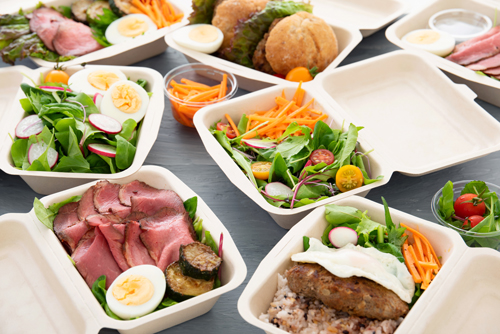With 2020 being the year that it was, we are all looking forward and seeing what 2021 has in store for the foodservice industry. In 2021, many food trends we saw will likely carry over from 2020, especially as the COVID-19 pandemic continues and people slowly begin to dine in, eat outdoors, order take-out, and get more things delivered. Below are a few trends that foodservice industry leaders, forecasters and market researchers see on the horizon for 2021:
Plant-Based Foods
Plant-based food diets focus on foods primarily from plants. This includes not only fruits and vegetables, but also nuts, seeds, oils, whole grains, legumes and beans. It does not mean that consumers are vegetarian or vegan and never eat meat or dairy. Rather, they are proportionately choosing more of their food sources from plants. Plant-based menu items continue to be a trend into 2021, as 28 percent of people said that they have been eating more protein from plant sources during the pandemic, according to IFIC (International Food Information Council).
Expect the usual suspects to be rolling out even more innovations, especially at fast-food restaurants, but some forecasters predict newer things like plant-based "fish" “pork” and “chicken” are also going to be big in 2021.
Healthier CocktailsConsumers will be looking for fresher, “healthier” cocktails in 2021. People are now in search of alcohol-free spirits and low-calorie alcoholic beverages, including the ever-so-popular seltzers and other beer alternatives. According to Instacart, hard kombucha is up 320 percent in searches across the marketplace and searches for brands across the hard seltzer category were up 519 percent from 2019.
Homemade craft cocktails were also popular in 2020 with many people working from home and the shutdown of many happy hour bars. “We've seen sales for trendy alcohol-free spirits boom, increasing by 195 percent year-over-year,” according to Laurentia Romaniuk, Trend Expert and Senior Product Manager at Instacart. She goes on to say, “Perhaps consumers are looking to turn over a new leaf in 2021 with tasty, guilt-free libations."
Comfort FoodFor 2021, the trends will go towards comfort and simplicity. Due to the pandemic, most of us are looking for a sense of comfort and normalcy. “I think people will run to comfort food. Anything that reminds them of what it used to be like. Classic pizzas (no pineapple), burgers without a bunch of crazy toppings, real tacos (not fancy wraps), old-fashioned barbecue, mac and cheese, country fried steak, fried catfish, biscuits and gravy … you name it, as long as it tastes good, someone else makes it, and it’s not at your house!” says Erik Niel, chef of Easy Bistro & Bar and Main Street Meats in Chattanooga.
Instead of chefs and restaurant operators striving to find the newest ingredient, 2021 will focus on getting back a sense of balance. People just want to gather and socialize while feeling safe. Instead of fixating over a rare new superfood, restaurants will move forward by providing guests with feel-good food options.
Eco-Conscious PackagingIn a year when to-go packaging demand increased rapidly with the surge of takeout and delivery, owners and operators were sometimes left scrambling. The packaging industry is responding with new designs, materials and other innovations, many of which will carry on beyond 2021.

Sustainable packaging will become a priority in 2021. In 2020, operators had to use any kind of packaging they could find to meet the demand. As the coronavirus spread, recycling also took a backseat, resulting in what some environmentalists are calling a “plastic tsunami.” But environmentally conscious consumers and operators are eager to get back to more sustainable solutions.
A Greater Effort to Go Waste-FreeThe pandemic has brought immense shifts in supply chains. Proteins have seen the biggest change in availability and price since COVID-19; ground beef, portioned steaks, and poultry have all been either scarce or seen an increase in price. According to industry forecasters, there will be a larger, “no waste” approach to protein selection and use, especially in restaurants. We should also expect to see more seasonal daily menus rather than large menus that only change once to twice a year for restaurant owners and operators to adapt to changes in the market.
Ghost Kitchens and Touchless ServiceTakeout and curbside were popular additions to many restaurant operations in 2020 in order to stay afloat. Takeout and curbside allow restaurants to bring in revenue despite lockdowns and dine-in restrictions.
In addition to traditional takeout and curbside services, ghost kitchens became the hot new restaurant industry trend in 2020. Ghost kitchens provide the “kitchen” component of a restaurant operation without the on-premises dining or direct customer interaction. This contactless kitchen model focuses on take-out service only, delivered primarily through delivery apps such as GrubHub and UberEats. With the development of COVID-19 and stay-at-home guidelines, many restaurants had to close their dining rooms, leaving them with a choice: either temporarily close, increase their existing takeout options or adapt new ones.
“Expect to see more ghost kitchens or ghost food halls operated out of commissaries in 2021. We’ll also be using more tech to better get your product to market (and seamlessly). Think touchless pickup and payment,” says Rick Camac, Dean, Restaurant & Hospitality Management at the Institute of Culinary Education.
Sanitation, Sanitation, SanitationThe pandemic brought drastic changes to our everyday lives, and many of the newly adopted behaviors are not going anywhere in 2021.
Restaurant owners, chefs and operators most likely began planning their reopening the minute they had to close their dining rooms. Restaurants shifted their focus to training their staff on sanitizing procedures. Most also went to single-use menus or the use of digital menus, via QR codes. Before reopening their dining rooms, many operators added sanitation stations throughout their restaurants, put plexiglass dividers between booths and tables, and added an advanced air filtration system. Many also have one person dedicated to sanitizing tables, chairs and booths between guests. “Spending is up 10% to 20% for additional staff,” says Jay Bandy, owner of Norcross, Ga. based Goliath Consulting.
Shipping Containers and Outdoor DiningOutdoor dining is not a new phenomenon. However, it was critical in restaurants’ survival in 2020. In warmer states and when the weather warms in cooler states, outdoor dining will continue to be essential in 2021. With indoor dining capped at 25%-50%, outdoor dining allows restaurants to maximize sales. Even if capacity restrictions are lifted in 2021, outdoor dining will help make up for past losses. Restaurateurs should be creative with the experiences they deliver outdoors, enticing customers to return.

A trend that was taking off prior to the pandemic and indoor dining being shut down was shipping containers converted into outdoor dining environments. These containers have structure, can be transported and can provide a 'pop up' dining opportunity.
Restaurant owners and operators will have to leverage these and other innovative ideas to retain customers and keep their doors open in 2021.
Did you enjoy this article?
Subscribe to stay up to date on industry news and receive exclusive sales and promotions.


